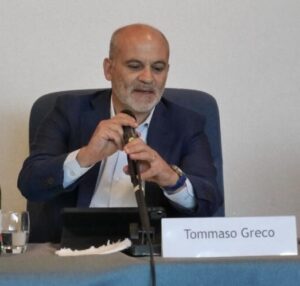by Pere Brunet
I lived my first twenty years in the Gracia district of Barcelona, a small town that was swallowed up by the big city in the 19th century and that still maintains some of its ancestral characteristics: connection between people, local commerce, proximity to all essential services. Then, I spent almost twenty years in Can Serra, a district of Hospitalet de Llobregat in the metropolitan area of Barcelona, which grew about 60 years ago as a dormitory enclave to “welcome” the immigrant labour that the big city required. In Can Serra I experienced constant demands for minimum services that would allow people to live with dignity, and I understood that each plot meant a contradiction between the speculative desire and the needs of people. In Can Serra I lived with people, I made friends, but I also discovered the abysmal distance between some urban environments and others.
Do cities solve our needs? Are the so-called “smart cities” proposals useful? Do they make life easier for their people? Boaventura de Sousa Santos, director of the Center for Social Studies at the University of Coimbra (Barrero, 2018: 39-54) believes not. He explains that it is not true that most people in the world live in cities: they work in cities, they go through cities, but they do not live in them. The majority, instead of living in urban spaces, live in de-urbanized areas without services or public spaces and without urban coexistence. Since large cities lead to most of their people living in what they call “sacrifice zones”, he says that we must design another type of city: the cities of Peace, which are nothing else than areas that take care of their people.
Cities were created as places for the protection of their inhabitants, but in many cases, and basically in the peripheral environments, they have ceased to be so. This is because the main objective, which is to care for their people, has been forgotten. Carmen Magallón (Barrero, 2018: 57-60) explains that it is necessary to assume in depth the vulnerability, individual and group, of all: that of the dispossessed and the powerful. Vulnerability is not something conjectural, it is an essential characteristic of humans. Assuming vulnerability leads us to priorities and policies that must be consequently oriented towards cooperation and mutual support. And, as the main objective is to take care of people, the means should include protecting them, addressing their vulnerability, proximity and abundance of basic services, peace of mind (see map of slow cities in CittaSlow, 2020) and the guarantee of a universal human security (decent housing, food, health, education, culture and more) based on respect for human dignity (Gómez, 2020). Experience shows us, however, that for all of this to be possible, the size of cities must be limited.
We are surrounded by empty words. A friend who lives in Vienna, a city that considers itself a “Smart City”, recently commented that no one had noticed any effect from this; everything has been, he said, an “image operation”.
The slow city movement criticizes urbanism based on economic objectives, which generally involves mega-projects to build mega-cities. As an example of cities that do not want to grow any more, we have two German cities, Hersbruck and Waldkirch, with 12,000 and 20,000 inhabitants. Since they have begun to implement projects based on the philosophy of slow cities, they are more cohesive, have entered a phase of prosperity, and they can avoid pressures that would like to attract large corporations with their own economic interests.
Hardly anyone asks questions like the following: what is the optimal size for a city?, is there a limit to the growth of cities?, or, do I live in a too big city? Some researchers such as (Camagni, 2012) have raised this question, concluding that a good number of European cities have exceeded their “human” limit (above a certain size, cities lose their protective function). And Jason Hickel (Hickel, 2016) explains it very clearly: we need a “steady state economy that maintains ecological balance … it is entirely possible to reduce resource consumption while increasing the things that really matter: human happiness, wellness, education, health and longevity”.
It is not easy to answer the question of what is the optimal size of a city, but the important thing is to ask ourselves the question. Because everything is limited: the planet, its resources, biodiversity, water, our standard of living. Vulnerability reminds us of our limits, and ecological balance reveals that humanly balanced cities can destroy themselves if they do not limit themselves.
We know that there is a limit to the size of cities, beyond which there can be too many people who end up living badly in un-urbanised areas on the city edges, and this is certainly what we don’t want. Personally, I would prefer to have cities of less than 100 or 200 thousand inhabitants, able of taking care of all their inhabitants.
If the objective is the people, we should think of humanly-friendly cities that, with a humanly-friendly size, would guarantee needs and provide human security for all their inhabitants. But this would require a major cultural change. Will we be able to address this?
A few references:
Ana Barrero, Coord. (2018) “Ciudades de Paz” (in Spanish), Foro Mundial sobre las Violencias Urbanas y Educación para la Convivencia y la Paz, Ed. Asociación Española de Investigación para la Paz (AIPAZ): http://www.ciudadesdepaz.com/wp-content/uploads/2018/07/libro_digital-CIUDADES-DE-PAZ.pdf
Roberto Camagni (2012), “One or infinite optimal city sizes?”: http://ires.ma/wp-content/uploads/2015/12/camagni-capello-caragliu_rabat_0912.pdf
Óscar Gómez (2020), “Human Security”, United Nations Development Programme, Human Development Report Office: http://hdr.undp.org/sites/default/files/human_security_guidance_note_r-nhdrs.pdf
Jason Hickel (2016), “The Contradictions of Economic Growth in an Era of Ecological Limits”, en “Engineering a Better World”, Royal Academy of Engineering, pp. 20-21: http://www.raeng.org.uk/publications/other/engineering-a-better-world-brochure
CittaSlow (2020), Slow Cities: Map of the network of cities that prioritize the quality of life of their people: https://www.cittaslow.org/
Pere Brunet, professore ordinario in pensione attivo in Informatica presso l’Università Politecnica della Catalogna a Barcellona

